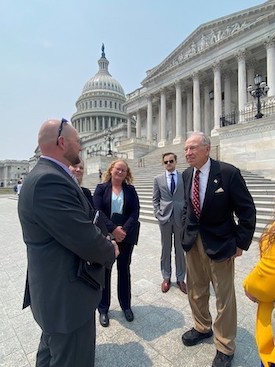USDA’s Federal Milk Marketing Order hearing in Carmel, IN, is providing the dairy industry with mountains of valuable information and insight that goes well beyond facts and figures.
The hearing isn’t only about shaping milk pricing; it’s also showing what needs improving in our industry, and it’s an opportunity to demonstrate what keeps dairy strong. And nothing is on display more emphatically than the power of dairy farmers and the cooperatives they own, and the importance of the cooperative structure to future progress in dairy, at all levels of production, processing and marketing.
Our breadth of membership and depth of milk marketing expertise has risen to every occasion during this hearing, relentlessly advancing the consensus proposal we adopted after two years of exhaustive study and discussion.
That plan, the only comprehensive solution that adequately makes the adjustments the FMMO system needs, would not have come about in the first place were we not able to rely on our farmer-cooperative members and staff to lead the industry. And without the unified voice a farmer cooperative provides its members in policy discussions, we never would have been able to achieve the unanimity in our membership that was necessary for USDA to take up our plan at all.
That final point is important. Cooperative membership holds multiple benefits for member-owners, beginning with having a guaranteed market for milk each day, but adding up to much more. Cooperatives provide technical expertise and risk-management assistance. Cooperatives pool supplies and capital, finance exports, enhance farmers’ bargaining position with proprietary processors, and even enable those farmers to become processors themselves.
These benefits have allowed dairy farmers to build multimillion-dollar processing plants in local communities, access needed financial resources, and capitalize on efficiencies in areas like milk hauling. Membership in a cooperative is the best way, and sometimes the only way, for a dairy farmer to get products to market and earn a decent return from doing so. Simply put, cooperatives make farmers stronger.
But for cooperatives to remain strong, they also need their members to actively engage.
That’s why it’s important to always remain vigilant against any effort to weaken cooperatives by limiting their ability to speak with a unified voice or adequately represent the best interests of their members. From time to time we hear of efforts on Capitol Hill or elsewhere to dilute the power of cooperatives to speak with one voice on votes on issues such as the Federal Milk Marketing Order system. Offered under the guise of encouraging individual choice, in practice these efforts are more like “divide and conquer” – chipping away at the benefits cooperatives provide by weakening their ability to pursue their members’ best interests.
Such efforts tend to be pursued by the same interests that, in the end, would rather that co-ops go away: companies that would prefer the benefits (to them) of vertical integration; agribusinesses that would rather not bargain with co-ops to get a better price for farmers; individual farmers who don’t feel they “need” co-ops to succeed (even as they buy inputs and sign contracts with them); and political ideologues who just don’t like the idea of farmers helping one another for mutual benefit. We’ve always been able to successfully resist them because, in the end, we use the very power we have to work together and protect our members’ interests.
As we celebrate October as National Co-op Month, with Farm Bill discussions underway and FMMO modernization making its way toward an eventual producer vote, we stand ever ready to defend cooperatives and their principles. Every day, at the federal order hearing in Indiana, we’re proving just how valuable to dairy the cooperative model remains. And every day across America, on farms, in milk trucks and in supermarkets, we remain proud of all we do to facilitate orderly marketing of milk and keep this nation nourished – and will continue to do so, with a strong, united voice, for many years to come.
Jim Mulhern
President & CEO, NMPF


 Farm bill negotiations, an effort to modernize the Federal Milk Marketing Order system, and an ongoing dairy labeling battle provided up-and-coming dairy leaders with no shortage of topics to discuss with members of Congress and their staffs on Capitol Hill.
Farm bill negotiations, an effort to modernize the Federal Milk Marketing Order system, and an ongoing dairy labeling battle provided up-and-coming dairy leaders with no shortage of topics to discuss with members of Congress and their staffs on Capitol Hill. The program’s webinar series is open to all eligible dairy farmers and industry affiliates and available at no cost. The 45-minute webinars, each covering a different topic, are held quarterly. Recent topics include an update on NMPF’s modernization efforts, finding work/life balance on the farm, and a panel discussion about challenges women face in reaching dairy leadership positions.
The program’s webinar series is open to all eligible dairy farmers and industry affiliates and available at no cost. The 45-minute webinars, each covering a different topic, are held quarterly. Recent topics include an update on NMPF’s modernization efforts, finding work/life balance on the farm, and a panel discussion about challenges women face in reaching dairy leadership positions. By Paul Bleiberg, Senior Vice President, Government Relations, NMPF.
By Paul Bleiberg, Senior Vice President, Government Relations, NMPF.



